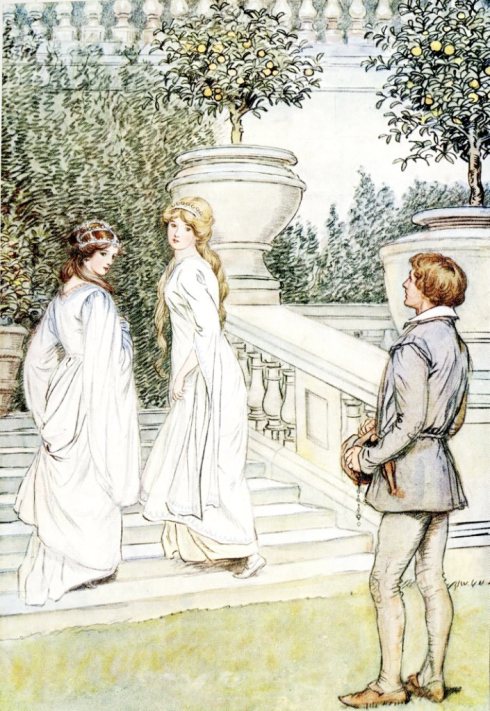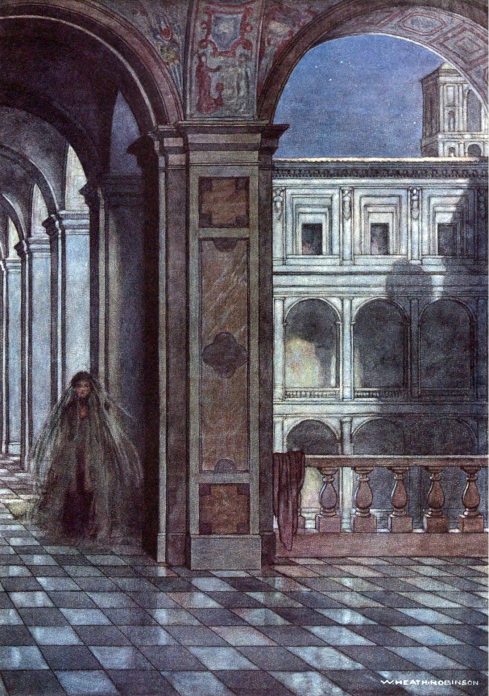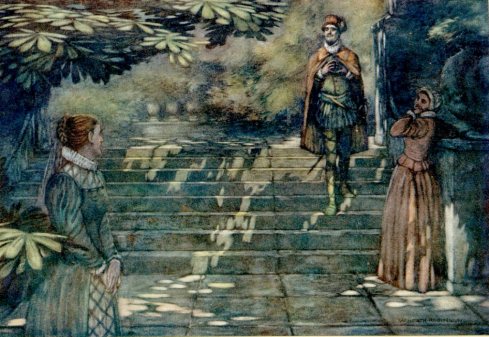As promised a short while ago, this week’s post returns to our friends the book illustrators Hugh Thomson and Herbert Railton who combined in the 1880s at the early stages of both their careers (Thomson was born in 1860, Railton in 1857) to provide dozens of pictures for W. Outram Tristram’s nostalgic look at the days of stagecoach travel, “Coaching days and coaching ways”. (1888). The Victorians and the Edwardians were just as nostalgic for the colourful past as we are today. Have a look here at some period drama, or at any of the posts on the Chelsea Pageant.
The author and his “able illustrators” make a good combination. Thomson was good at people, creating light-hearted scenes of rural and small town life, but his work was often combined with some fairly pedestrian views of town and country, as in some of the volumes in the Highways and Byways series about British counties to which he contributed. (We’ve seen his London volume,where his are the only pictures worth looking at. ) In this book he had a partner who was his equal. Railton’s strength was atmospheric views of places, whether parks and rural views or dark inns and alleys.
A typical Thomson scene, in which a young woman gathers her wits and her headgear after a coaching mishap:

(“A snapped pole” from the Brighton Road chapter.)
And a typically spooky view by Railton of a narrow cobbled street with shady corners, quiet for the moment as two cats have an encounter.

I was a bit mean to Mr Tristram when I wrote about his later book Moated Houses (entirely illustrated by Railton), calling his writing style pompous, rambling and obscure. Which it is, but I have to admit that Coaching days is a rather easier read. It’s anecdotal, and still verbose but that kind of works with this subject. The book is a set of essays originally published in the English Illustrated Magazine between October 1887- and July 1888, making it into book form late in 1888. This is a time of looking back from a new industrial, high speed society to a semi-rural past, before the railways covered the country, when the only means of long distance transport was the coach. A network of routes criss crossed the country served by coaches large and small, speedy and slow. Coaching inns were the nodes of this network, linking the cities with the small towns and villages, taking people on business and pleasure.
Mr Tristram says: “I shall show our ancestors…busy at those nothings which make travelled life – eating, drinking, flirting, quarelling, delivering up their purses, grumbling over their bills…I shall picture these worthies in all sorts of positions – on the road and off of it, snowed up, in peril from the great waters, waiting for the stage coaches etc, alighting at the inns – those inns for which England was once famous, with their broad corridors, their snug bars, their four-poster beds hung with silk, their sheets smelling of lavender, their choice cookery, their claret equal to the best that could be drunk in London.”
And that’s what he does, wandering through time and space like a modern travel writer, or even a psycho-geographer. (I use that term too much, I know.) His two collaborators go with him. (The three were acquainted from other assignments for the EIM.)
Mr Railton did people as well as cats, but they were often depicted engaged in lonely pursuits, adding some scale or proportion to views like this one.

Here we’re in Chester (as I was a couple of weeks ago) from the chapter called the Holyhead Road. Then as now the Rows (early multi level shopping) were the characteristic feature of the city, enjoyed by travellers and guide books.
By contrast, this view of the high street in Bath is teeming with people by Railton’s standards. In the chapter on the Bath Road Tristram follows various literary figures on their journeys, including Miss Fanny Burney and Mrs Thrale who went there in 1780. Miss Burney found the “houses elegant, the streets beautiful, the prospects enchanting..” She and Mrs Thrale found lodgings on the South Parade “It was deliciously situated. We have meadows, hills, Prior Park, the soft-flowing Avon, whatever Nature has to offer, I think, always in our view.” Something for the 18th century trip adviser.

Thomson sticks with the action, whether mundane, as below where four men make a meal of packing while a woman does the fetching and carrying,

clandestine, as a young lady has a private word with a gentleman, (Some long distance relationships must have been created in this communication network.)

or frantic, as in this case, simply titled “Eloped”, which tells you all you need to know.

Some of the coaches were noted for the tremendous speed with which they travelled. (Some of them were called “rockets” because of their great pace.) Thomson’ horses were much liked by readers and critics. One said: “he showed perhaps more mastery of the horse in action than of the feminine charm that was later to be so conspicuous a feature of his work”
And his sense of drama was well developed already. Sometimes speed and conditions combined to create minor (and major) disasters along the way.

“In a snow drift”. Horse and man in a tricky situation.
Along the way, Tristram takes in some local colour. Below, that old standby the haunted room, encountered on the Bath road but the exact nature of the haunting is not specified. It is though made for Railton’s atmospheric skills.

As is this view of the Mote (Moat) House at Ightham, on the Dover road.

Mr Tristram had some supernatural fantasies about Ightham recorded in Moated Houses which I transcribed in my first post about Railton (link above).
He had plenty of examples of the dark corners of small cities.

College Hall, Exeter. Below, architecture is combined with water as it so often is in his work.

The Old Hospital, Canterbury. Is the street totally waterlogged or are we seeing the play of light on puddles of water observed by Railton?
As well as the action, Thomson was good on the longeurs of coach travel. There must have been quiet times at the inns between arrivals and departures.
Here a mixed group is waiting for the coach.

Railton too looked at quiet moments in the courtyards of inns

(The George, St Albans. A girl pulls a toy vehicle along.)
Thomson, always good at depicting lounging, slouching and hanging around shows some useful inactivity during the down time at an inn.

And some people hoping to get some down time. At many times of the day travellers come to their journey’s end.

While some others are waiting, patiently or otherwise, like we wait for a bus.

When the coach does come it’s time for someone to cry out: “all aboard!”.

Squeeze in the carriage, or next to the driver, savour the restlessness of the horses, as eager to be off as the passengers and let’s go!

Postscript
As I hinted last time I thought I would take a couple of weeks off blogging. Time off is always good preparation for more time off so forgive me if this post is going out later than usual. My colleague Isabel pointed out that I’ve been doing weekly posts for nearly six years. Who would have guessed when I started? At some point late in this year we will reach a million page views. Not bad, I think.
By way of compensation for the hiatus there are more pictures than usual. If you’re yet to take time off, have a good one when you do. I’ll try and get back in the saddle.
 This hall is pleasantly cluttered with a seemingly random collection of art objects. It seems to be a common feature in the rooms of Luker’s friends, like at Lowther Lodge. (An interesting building in itself.)
This hall is pleasantly cluttered with a seemingly random collection of art objects. It seems to be a common feature in the rooms of Luker’s friends, like at Lowther Lodge. (An interesting building in itself.)



































































































































































